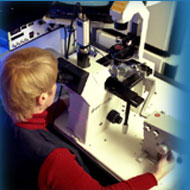
Environmental Factor, May 2008, National Institute of Environmental Health Sciences
Cancer Researcher Speaks at Postdoc Seminar
By Robin Arnette
May 2008

Several times a year, the postdoctoral fellows who make up the Genetics Training Action Committee (TAC) in the Laboratory of Molecular Genetics invite distinguished scientists to NIEHS to talk about their work. On April 7, TAC held its second seminar of 2008, which featured cancer researcher Joann Sweasy, Ph.D. Sweasy presented a talk on "Aberrant Base Excision Repair and Cancer" in Rodbell Auditorium. Libertad García Villada, Ph.D., a visiting fellow in the Spontaneous Mutation & DNA Repair Group, introduced the speaker.
As an associate professor of Therapeutic Radiology and Human Genetics at Yale University School of Medicine, Sweasy(http://info.med.yale.edu/genetics/fac/JoannSweasy.php) ![]() investigates the relationship between mutations and cancer and specializes in understanding DNA polymerases. Sweasy said that DNA polymerase β (pol β) was altered in 30 percent of all cancer tumors that have been studied. The finding implies that some pathway, perhaps base excision repair (BER) or an aberrant form of it, may be used when a tumor propagates. She believes figuring out the mechanism behind this phenomenon will help in the fight against cancer.
investigates the relationship between mutations and cancer and specializes in understanding DNA polymerases. Sweasy said that DNA polymerase β (pol β) was altered in 30 percent of all cancer tumors that have been studied. The finding implies that some pathway, perhaps base excision repair (BER) or an aberrant form of it, may be used when a tumor propagates. She believes figuring out the mechanism behind this phenomenon will help in the fight against cancer.
To determine if the pol β variants were related to cancer, Sweasy and collaborators subcloned either the wild-type pol β or variant pol β, in this case a prostate cancer-associated variant, into a retroviral vector that conferred a tetracycline (tet) on/off control. If tet was in the culture medium, pol β expression would be turned off. In the absence of tet, pol β expression would be turned on. The team infected mouse cells with the vectors, grew them in media without tet and selected stable clones. "We passed the cells and every five passages or so, we set some aside for the focus formation assay,” Sweasy noted. "The cells with the variant pol β had focus formation, which meant they had lost growth control and were growing on top of each other. Focus formation didn’t occur in wild-type pol β cells.”
Sweasy performed the next set of experiments by growing these same variant pol β clones in media containing tet. Since pol β expression should have been turned off under these conditions, she didn’t expect to see focus formation in the variant, but she did. Western blotting confirmed that pol β wasn’t being expressed, so she was curious about what had happened. She said, "For us that meant something had happened to change the cell permanently, and that was probably mutagenesis." This observation lead Sweasy and her colleagues to ask the next logical question about the association of pol β variants in tumor formation: Can pol β cancer-associated proteins induce mutations that lead to cellular transformation?
To answer this query, Sweasy subjected wild-type and several pol β cancer variants to a HSU-tK forward mutation assay, which allowed her to determine the fidelity of the polymerases. In other words, she wanted to know if the variants were making more mistakes when synthesizing DNA than wild-type pol β. The results demonstrated that both the wild-type and the variants had a similar frequency when synthesizing DNA, but she noticed that in a particular HSU-tK target sequence, pol β behaved differently in one of the variants. "We saw that wild-type typically makes deletions in this specific section of sequence, while the prostate cancer-associated variant inserts TC repeats," she explained. "That tells us that the variant is seeing the DNA differently from the wild-type."
Sweasy said that these and other studies led her group to hypothesize that there are three different mechanisms that are associated with pol β cellular transformation in cancer: mutator polymerases, polymerase-deficient activity and dRP lyase-deficient activity. dRP lyase (5′-deoxyribosephosphate lyase) activity is the rate-limiting step in the single nucleotide BER pathway of damaged DNA.
As an established biomedical researcher, Sweasy is used to accepting seminar invitations from other senior scientists, but she was especially thrilled to have had an invitation from postdoctoral fellows. "It’s such a pleasure to be asked by the postdocs," she said. "I’m really honored and excited to be here."
"Former Postdoc Awarded..." - previous story ![]()
![]() next story - "Laureate Cautious..."
next story - "Laureate Cautious..."
May 2008 Cover Page



